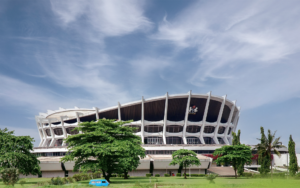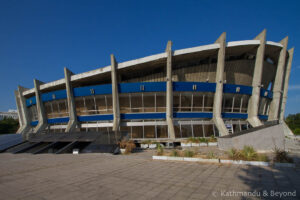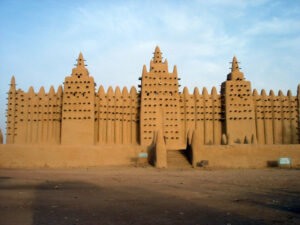Who should redefine African Architecture?
What role can the creative industries play?
On the 6th of July, 2023, The Sahara Centre was invited as a guest speaker by Open House Lagos (OHL) and NowNow to discuss redefining African architecture and the role architecture competitions play in decolonizing identity in Africa.
The event was moderated by Adeposi Stanley from OHL and Sebastian Hitchcock of the NowNow competition. The speakers included: Dieudonne Elohym, an architecture student at Cape Peninsula University of Technology; Mayankh, an architect, entrepreneur, and educator; Ismaeel Davids, a Masters of Architecture graduate from the University of Cape Town; and Elouise Asem, an architect and Centre Manager at The Sahara Centre.
This write-up presents The Sahara Centre’s contribution and reflections on the theme.
The theme presents interesting and powerful questions that need to be answered delicately. What is African architecture? Who is responsible for its definition and redefinition? What role do architecture competitions play in promoting a stronger sense of African identity? How does this contribute to the decolonization of identity in Africa?
Architecture is an important identifier of how people see themselves, how they live, and their value systems. However, a brief outlook on city master plans in Africa shows that African architects continue to build according to Western narratives and standards. This leads to the question, of who is an African architect. Someone of African origin? Someone who studied or lives in Africa? Or someone who identifies as an African architect? This tenuous link presents tensions that can’t be unpacked in this write-up, but interested readers can read more on this in Vanessa Watson’s research on African urban fantasies or Tabitha Lawason’s research series on Architecture and Politics in Africa.
For the purposes of this conversation, we refer to African architects as architects practicing in Africa. These architects have been accused of being slow to challenge Western standards. By merely speaking to architects, the question of providing services to clients arises. Who will educate/who should educate the clients? That is a topic for another conversation. However, where the ‘client’ is the government and the case is a competition open to architecture firms to submit designs, what does it mean for the continent?
Who should build Africa? There are examples of non-African architectural practices winning competitions to design African cities. At face value, there appears to be nothing wrong with this. However, the issue arises of how the cities are designed and the reflections and considerations of the urban fabric, way of life, and peculiar contexts. In particular, these cities are designed to ‘erode’ rather than celebrate the evolution of place and anchor this in a sense of place and belonging for its users. For example, the National Theatre, one of Lagos’ iconic landmarks was designed and constructed by Techno Exporstroy
For example, one of the most iconic landmarks in Lagos, the National Theatre, was designed and constructed by a Bulgarian company, Techno Exporstroy. A design that was in fact taken from the Palace of Culture and Sports in Varna, Bulgaria. A landmark that was indeed brought forth to celebrate Nigeria’s art and culture was copied without proper context.


This viewpoint is delicate and potentially contentious. So how about we look at the question of if African architects should be able to respond to competitions on other continents? You can see how this cannot and should not be the angle to approach the conversation.
Rather, it is a question of responsibility for whoever is designing the competitions and the respondents, as well as those overseeing and awarding the contracts to build the Africa of the future.
What is unique and required for African buildings of the future? Firstly, they should tie into the space and weave the narrative of the city. See Collage City (a book by Colin Rowe and Fred Koetter, former dean of Yale School of Architecture) for an interesting perspective on how cities can be built to preserve the different facets for various users.
Africans have built in a diverse and rich range of styles, using materials and techniques that reflect the continent’s historical, cultural, and environmental contexts. African architecture is deeply rooted in customs and beliefs, and these interpretations vary according to the region. Within this diversity, there are some key characteristics: local design to address the needs of the communities, climate-appropriate and natural materials (mud, thatch, stone, and wood), shapes and forms that blend with the environment, in harmony with nature, materials that provide natural insulation, the use of courtyards for meetings; natural ventilation and lighting; and have decorative features, carvings, and patterns.


These examples are inserted to provide a sense of what was, and not necessarily what should be, as traditions and practices are meant to evolve. The question is how these traditional elements are blended with design approaches that create innovative and sustainable buildings that reflect the continent’s heritage whilst being able to meet the needs of present and future users.
Enter the creative industries.
Some of the industry’s sectors—design, film, fashion, music, visual arts, and literature continue to play an important role in how African architecture evolves. Firstly, how do we embrace our cultural identity and promote avenues that can inspire, and inform architects (in Africa and outside of Africa).
Where do we begin to draw the line between imitation and aspiration? How do we begin to design cities that are truly African? These questions are especially relevant to the development of our present cities and the vision for the cities of the future.
The creative industries have the ability to shape culture and move communities towards a shared interest. Here are some ways the creative sector can influence a large-scale shift in mindset.
Defining and amplifying narratives of what it means to be an African city. By truly understanding the damaging effects colonialism has on the African fabric, we can begin to establish narratives built on the historical and contemporary context of the architecture of the city; we can begin to shape a shared vision. African narratives, through storytelling and representation across various mediums, can diffuse innovations and influence architects, planners, and builders
Fostering cross-disciplinary collaboration between artists, architects, urban planners, and other professionals focused on developing innovative and holistic approaches to African architecture. The blending of perspectives and expertise can result in more culturally sensitive and contextually relevant design solutions.
Celebrating timeless African architectural heritage to promote African culture, traditions, and architectural heritage. These artistic expressions and cultural events showcase the richness and diversity of indigenous architectural styles, materials, and building techniques, encouraging their integration into contemporary designs.
Re-use of existing structures as cultural hubs, museums, performance spaces, and creative spaces, to revitalize, and promote cultural tourism and a sense of pride.
As we design and plan the buildings of the future, we need to upskill those who will build these structures, skilled designers, and artisans who can build. There is a role to play in upskilling these people as well.
In this journey, and it must be seen as a journey, there needs to be intentional unlearning and relearning. The pursuit of authentic, culturally-rooted architecture requires a fundamental shift that entails unlearning decades of colonial influences. This transformation demands deep reflection and collaboration between designers and the communities they serve, even as the focus is towards a harmonious blend of old and new, bold in its vision, and ultimately serving the needs of the community.
Overall, African architecture focused on identity (and by extension, decolonization) has the potential to foster a transformative dialogue, challenge existing norms, and inspire architects and planners to create spaces that honor the continent’s rich cultural heritage while addressing contemporary needs and aspirations. By continuing to encourage conversation and collaboration within the creative industries, we can begin to see a shift in mindset and eventually a positive reflection of what it means to design for African cities.
